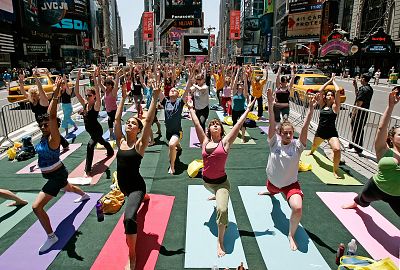It's the longest day of the year in the northern hemisphere.
The summer solstice is an annual astronomical phenomenon that brings the longest day of the year in the northern hemisphere (and the shortest night). It's also a key cultural event in many ancient and contemporary societies.
The 2018 summer solstice in the northern hemisphere will occur on June 21 at 6:07 a.m. EDT, about 45 minutes after sunrise on the East Coast but before dawn across most of the U.S.
What is the astronomical basis of the summer solstice?
Earth's rotational axis — the imaginary line through our planet's center and the geographic north and south poles — isn't exactly at a right angle to the path of its orbit around the sun. Instead, it's tilted at an angle of about 23.5 degrees from vertical — possibly as the result of a collision with another planet-sized object billions of years ago, when the solar system was forming.
As Earth orbits the sun over the course of each year, its axis always points at the same direction in space. That means the northern hemisphere is angled toward the sun for half the year and angled away for the other half. The moment when the north pole is nearest to the sun is called the summer solstice in the northern hemisphere; the time of year when the north pole points furthest from the sun is called the winter solstice.
In the southern hemisphere, the solstices are reversed. The winter solstice there comes in late June and the summer solstice in late December. The exact dates of the solstices can vary by a day or two.
How does the summer solstice affect Earth?
When the northern hemisphere is tilted toward the sun, sunlight falls at a steeper angle on it to cause the hot months of summer. The farther north you live, the longer the hours of daylight around the time of the summer solstice. Inside the Article Circle — the area within roughly 25 degrees of the north pole — the sun never sets at this time of year.
Astronomers count the summer solstice as the first day of summer. But though the days are at their longest around the summer solstice, the hottest part of the year is still to come. It takes about a month for the climate of the northern hemisphere to warm up in the abundant sunlight — a phenomenon known as seasonal lag.
What about the cultural aspects of the summer solstice?
Solstice means "sun standing still" in Latin, a reference to the fact that the sun appears to linger at its highest point in the sky for the year at midday on the summer solstice.
This phenomenon has been observed since ancient times and may be one of the earliest astronomical observations in human prehistory. Knowing the yearly cycle of the seasons was vital to the survival of ancient people, and both the summer and winter solstices were key dates in the calendar.
"People in antiquity were very aware of this kind of thing," said Ed Krupp, director of the Griffith Observatory in Los Angeles. "It was very closely linked to the seasons, and seasons are directly linked to human behavior and activity and resources."
Several ancient monuments around the world are believed to have been designed to align with the rising or setting sun at the summer solstice. These include the Bighorn Medicine Wheel near Lovell, Wyoming and Stonehenge, the 5,000-year-old stone circle in Wiltshire, England.
In Europe and other parts of the world, midsummer festivals keep alive the memory of ancient summer solstice rituals. Other modern observances include talks by astronomers about the summer solstice, such as the sunset presentation at the Griffith Observatory. And thousands of people are expected to attend a ceremony for the summer solstice sunset at Stonehenge, which in recent years has taken on the feel of an outdoor music festival.












